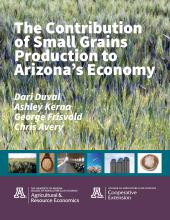The Contribution of Small Grains Production to Arizona‘s Economy

Small grains, in particular wheat and barley, are an important part of Arizona’s agricultural economy. Durum wheat, the most common type of wheat produced in Arizona, is grown for a wide variety of domestic and foreign customers. Small grains, especially barley, have long served as a source of feed for the state’s large cattle feedlot and dairy industries as well as its hog, sheep, and poultry industries. Small grains play a critical role in maintaining soil and crop health for Arizona farms because other key agricultural crop sectors, such as those growing fresh produce and cotton, use small grains as important components of their crop rotations. Finally, Arizona mills, bakeries, food manufacturers, breweries, and distilleries also use small grains in a small, but growing local foods movement.
The contribution of small grains production to Arizona’s economy goes beyond the direct effect of the dollar value of grain harvested from the fields. Grain production requires inputs of goods and services, many of which are supplied by local businesses. These local businesses in turn require their own production inputs. These rounds of business-to-business transactions providing inputs are known as indirect effects. Incomes generated in small grains production (farm profits, wages, and salaries) are also spent by households for expenses such as rent or mortgages, doctor visits, and groceries, which produce more rounds of household-to-business transactions, known as induced effects. Because of these indirect and induced multiplier effects, the economic contribution of small grains in Arizona is considerably greater than indicated by farm gate sales figures.

